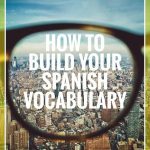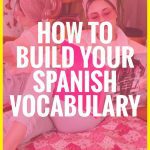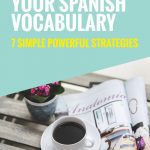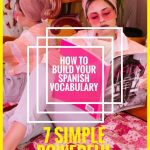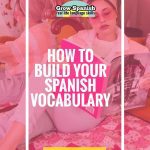7 Smart Strategies to Build Your Spanish Vocabulary
Are you tired of forgetting Spanish words you just learned? You’re not alone. Most learners struggle to make vocabulary stick—especially if they rely on random word lists, flashcards, or disconnected drills.
If you want a better way to build Spanish vocabulary, this guide is for you. Below are 7 proven strategies that make learning words more personal, practical, and memorable—no flashcards required.
Why Most Spanish Vocabulary Methods Fail
Traditional methods often focus on memorizing isolated words out of context. While tools like Duolingo and Quizlet can help with repetition, they don’t teach you how to actually use the words in real life. That’s why many learners forget words quickly or don’t know when to use them.
Here’s the truth: To remember Spanish words, you need to connect them to your life, interests, and habits.
🧠7 Smart Strategies to Build Your Spanish Vocabulary
These strategies are part of my personal framework, developed from years of experience teaching Spanish and learning other languages myself. Let’s dive in.
1. Track Your Words in a Personal Word Bank
Create a digital or physical list of the words you’re learning. Each time you encounter a new Spanish word, log it with:
- English translation
- An example sentence
- Notes or associations (e.g., rhymes, opposites)
Use categories like topic (food, travel, emotions) or part of speech to organize your vocabulary list.
Action Tip: Use a spreadsheet that auto-organizes and tracks your progress. My Spanish Word Bank does just that.
2. Use Your Daily Life as a Source of Words
Look around your home, office, or neighborhood. What objects or actions do you see every day? Learn those in Spanish.
- Label items in your kitchen
- Learn phrases related to your hobbies
- Describe your morning routine
This method turns your environment into a vocabulary classroom.
3. Make It Visual: Draw or Collect Images for Each Word
Instead of memorizing abstract words, tie them to visuals. This taps into your brain’s image-processing power.
- Draw quick sketches of the word
- Add emojis or icons next to word entries
- Search for relevant photos online
Don’t worry if you’re not an artist—stick figures work too!
4. Create Flash Sheets® Instead of Flashcards
Flashcards are static and often boring. A Flash Sheet® is a flexible, reusable worksheet where you practice:
- Translation recall
- Word forms
- Contextual usage
It’s like a personal Spanish quiz sheet—more engaging than flipping cards.
✨ My vocabulary spreadsheet includes ready-made Flash Sheets® that fill automatically from your Word Bank.
5. Activate New Vocabulary Through Writing
Use your target words in short, meaningful writing:
- Write a sentence or paragraph using 3–5 new words
- Journal about your day in Spanish
- Describe a photo using key vocab
This strengthens recall and context.
6. Track Progress with Color Coding or a Weekly Log
Track which words you’ve learned, reviewed, and mastered:
- Color code your spreadsheet (red = new, yellow = in review, green = mastered)
- Log your weekly vocabulary goals and wins
This gives you a visual of your growing vocabulary—and keeps you motivated.
A progress tracker is built into the Vocabulary Toolbox I use and recommend.
7. Create Custom Word Lists Based on Topics That Matter to You
Instead of studying someone else’s list, build your own based on your lifestyle:
- Travel Spanish
- Parenting phrases
- Cooking and food vocab
- Work-related words
These words will actually show up in your life—so you’ll be more likely to remember and use them.
Not quite ready to dive in with the full tool?
No worries — start small with my free guide:
Final Thoughts: Learn Spanish Vocabulary That Sticks
If you’ve been relying on flashcards or random apps, it’s time for a smarter approach. These 7 strategies will help you:
- Personalize your learning
- Use your new vocabulary in real life
- Actually remember what you learn
Start small. Choose one or two strategies above and begin applying them today.
What’s next?
📌 Pin it
